Efficacy of totally laparoscopic compared with laparoscopic-assisted total gastrectomy for gastric cancer:A meta-analysis
Song Wang,Mei-Lan Su,Yang Liu,Zhi-Ping Huang,Ning Guo,Tian-Jin Chen,Zhong-Hui Zou
Abstract
Key words: Gastric cancer; Total gastrectomy; Esophagojejunostomy; Totally laparoscopic; Laparoscopic-assisted; Meta-analysis
INTRODUCTION
According to the 2018 cancer statistics,the incidence of gastric cancer ranks second and fifth of the various malignant tumors in China and worldwide,respectively; and its mortality rate ranks third both in China and globally[1].Surgical resection is still the main treatment for gastric cancer.With the rapid development of laparoscopic techniques,laparoscopic radical gastrectomy has been widely recognized and performed.The indications for laparoscopic surgery have gradually extended from early gastric cancer to advanced gastric cancer,and the surgical approach has also evolved from laparoscopic-assisted radical gastrectomy to totally laparoscopic radical gastrectomy.It is reported[2-4]that totally laparoscopic distal gastrectomy has many advantages,such as smaller scars,better visualization,fewer postoperative adhesions,and faster postoperative recovery,when compared with traditional surgery.However,it is difficult to complete totally laparoscopic total gastrectomy (TLTG)[5],as the safety and feasibility of intracorporeal esophagojejunostomy are uncertain,and TLTG is currently not widespread.In view of this,we hypothesize that TLTG is safe and feasible,and that the efficacy of TLTG is superior to that of laparoscopic-assisted total gastrectomy (LATG).The present meta-analysis was performed to compare their short-term efficacy and investigate the safety and feasibility of totally laparoscopic esophagojejunostomy for gastric cancer in order to obtain the best evidence to guide clinical practice.
MATERIALS AND METHODS
Literature search strategy
An analysis of clinical controlled studies on gastric cancer treated by TLTG and LATG published before October 2019 was conducted.PubMed,EMBASE,and Web of Science databases were searched for relevant studies written in English.The search keywords included:Gastric cancer/gastric carcinoma/stomach cancer,total gastrectomy,intracorporeal/total laparoscopic/totally laparoscopic/completely laparoscopic,laparoscopic-assisted/laparoscopy-assisted/laparoscopically assisted,esophagojejunal anastomosis/esophagojejunostomy,and a manual review of the references in the selected studies was performed to identify further publications.
Inclusion and exclusion criteria
Inclusion criteria:(1) Patients were diagnosed with gastric cancer by histopathological examination; (2) All published comparative studies on the efficacy of TLTG and LATG for gastric cancer; (3) Important intraoperative and postoperative clinical data were provided; (4) Primary statistics,continuous variables such as mean and standard deviation (SD) or median and range,and binary variables such as odds ratio (OR)were presented; and (5) For studies from the same department,high quality or recently published studies with a larger sample were selected.Exclusion criteria:(1)Studies involving proximal gastrectomy,distal gastrectomy,palliative total gastrectomy,or robot-assisted total gastrectomy in totally laparoscopic gastrectomy;(2) Studies involving non-stomach cancer; (3) Studies without a comparison of LATG and TLTG; and (4) Studies including patients with preoperative neoadjuvant chemotherapy.
Data extraction and quality evaluation
A unified data collection form was used,and information on the first author,nationality,publication time,sample size,age,body mass index (BMI),and important clinical data related to surgery were extracted independently by two systematic reviewers.If there was any disagreement,a decision was made after discussion with a third reviewer.
In this study,the quality of the included studies was evaluated by two independent reviewers using the Newcastle-Ottawa Scale (NOS)[6].The evaluation was made in terms of study selection,study comparison,and study outcome of interest.A study was awarded a maximum of one star for each numbered item within the Selection and Outcome categories.A maximum of two stars was given for Comparability.The full score was 9 points,and a score greater than 6 points was considered a high quality study.
Statistical analysis
Statistical analysis was performed using Review Manager software version 5.3(Cochrane Collaboration,Oxford,United Kingdom).The OR was applied to assess the dichotomous variables,and the weighted mean difference (WMD) was used to evaluate the continuous variables.If the mean values and SD values were not provided,they were determined based on the available median and range data as described by Hozoet al[7].Publication bias was evaluated by Egger’s test.Egger’s test was not suitable for subgroup analysis if less than ten studies were included.A heterogeneity test was performed on the included studies,andI2≤ 50% indicated no significant heterogeneity and a fixed-effect model (F model) was used,ifI2> 50%,a random-effect model (Rmodel) was chosen.An R model was chosen for all clinical data related to surgery,even if there was no statistical heterogeneity.A value ofP<0.05 was considered statistically significant.
RESULTS
Study selection
During the initial search,147 publications were selected.By screening the title and abstract,irrelevant studies were excluded,the the full-text of 14 studies were further assessed.Of these,five papers were excluded for the following reasons:three papers[8-10]were not written in English,one paper[11]included both total gastrectomy and distal gastrectomy,and another paper[12]involved laparoscopy-assisted proximal gastrectomy with double tract anastomosis.In total,eight studies[13-20]were considered for the meta-analysis (Figure 1).
Study characteristics and quality assessment
Eight controlled studies[13-20]of gastric cancer treated with TLTG and LATG were finally screened out.In total,1883 clinical cases were included,869 cases in the TLTG group and 1014 cases in the LATG group.No deaths were reported in any of the included studies.The main TNM stages of gastric cancer were I-III.Of these eight studies,four were from Korea,one from Japan,and three from China,and all were published between 2013 and 2017.Seven[13-19]studies reported the average age,and six[13-18]reported the BMI for each group.The meta-analysis showed that both age and BMI were not significantly different between the two groups (P> 0.05).Seven[13-19]studies had a NOS score ≥ 7 and were considered high quality studies.The basic information related to the included studies is shown in Table 1.
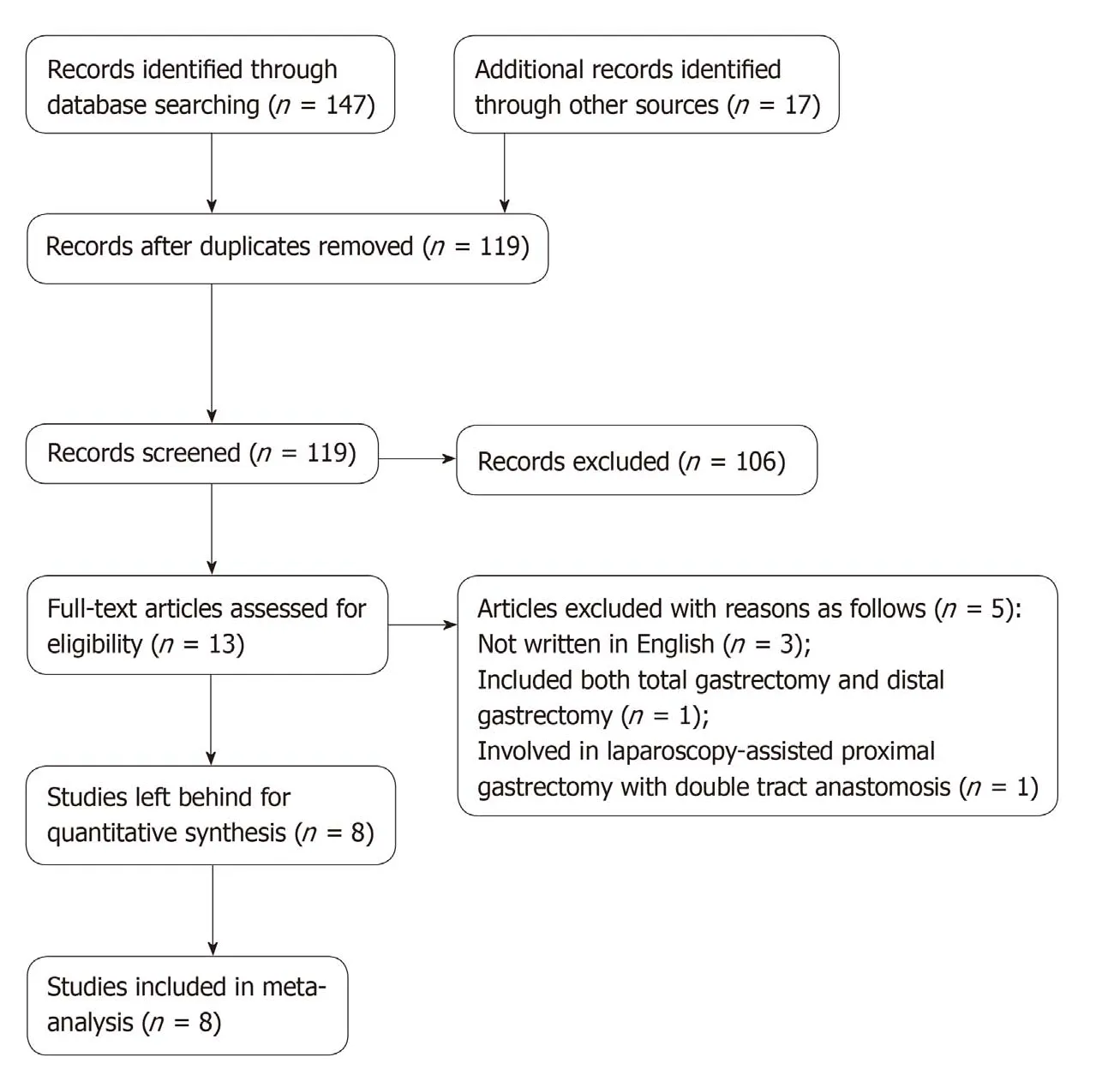
Figure 1 Flowchart of the search strategy.
Intraoperative outcomes
Seven studies[13-19]reported the operating time.The meta-analysis showed that there was no significant difference in operating time between the TLTG group and the LATG group (WMD = -4.84,95%CI:-11.62-1.95,P= 0.16; Figure 2A).Two studies[14,16]described the anastomosis time,and no significant difference was found between the two groups (WMD = 9.36,95%CI:-1.32-20.04,P= 0.09; Figure 2B).Six studies[14-18,20]reported intraoperative blood loss.The meta-analysis showed that intraoperative blood loss in group TLTG was significantly less than that in group LATG (WMD = -35.37,95%CI:-61.69- -9.06,P= 0.008; Figure 2C).Six studies[13-17,19]described the number of retrieved lymph nodes.The meta-analysis showed that a larger number of retrieved lymph nodes was found in the TLTG group compared to the LATG group(WMD = 3.11,95%CI:0.63-5.60,P= 0.01; Figure 2D).Seven studies[14-19]described the size of resected tumors.No significant difference in tumor size was found between the two groups according to the meta-analysis (WMD = -0.43,95%CI:-0.89-0.04,P= 0.07;Figure 2E).Five studies[14-16,18,19]reported the length of the proximal margin.The metaanalysis showed that there was no significant difference in the length of the proximal margin between the two groups (WMD = -0.28,95%CI:-1.12-0.56,P= 0.52; Figure 2F).
Postsurgical outcomes
Three studies[13,15,19]reported the postoperative pain score (visual analog scale).The meta-analysis showed that there were no significant differences in the pain score between the TLTG group and the LATG group on Day 1,3,and 5 after surgery (P=0.89,0.45,and 0.07,respectively).In addition,no significant difference in the peak pain score during the recovery period was found between the two groups (P= 0.70).Five studies[13,14,16-18]reported the time to first flatus.The meta-analysis showed that there was no significant difference in time to first flatus between the two groups(WMD = 0.07,95%CI:-0.09-0.22,P= 0.40; Figure 2G).Six studies[13-18]reported the time to first oral intake.There was no significant difference in time to first oral intake between the two groups according to the meta-analysis (WMD = -0.31,95%CI:-0.67-0.06,P= 0.10; Figure 2H).Six studies[13-18]reported the length of postoperative hospital stay.The meta-analysis showed that there was no significant difference in the length of postoperative hospital stay between the two groups (WMD = -0.78,95%CI:-1.74-0.19,P= 0.11; Figure 2I).All eight studies included[13-20]reported the incidence of anastomosis-related complications (anastomotic leakage,anastomotic stenosis,and anastomotic bleeding) 30 days postoperatively.The meta-analysis showed that thepostoperative anastomosis-related complication rate was not significantly different between the two groups (OR = 0.73,95%CI:0.38-1.40,P= 0.34; Figure 2J).Six studies[13-16,18,19]reported the overall rate of postoperative complications.There was no significant difference in postoperative complications between the two groups according to the meta-analysis (WMD = 1.00,95%CI:0.75-1.32,P= 0.97; Figure 2K).Intraoperative and postoperative information on the eight studies are summarized in Table 2.

Table 1 Baseline characteristics of the included studies
Sensitivity analysis
In the present study,we focused on the safety and feasibility of totally laparoscopic(intracorporeal) esophagojejunostomy,and a sensitivity analysis of all included studies was performed.Different anastomosis patterns may have an impact on the final results,and low-quality research may also affect the final findings.Among the eight studies included,seven[13-16,18-20]reported reconstruction using Roux-en-Y anastomosis,while Huanget al[17]reported an isoperistaltic jejunum-later-cut overlap method.Six[13-15,17-19]of the eight studies used a linear stapler for anastomosis and the NOS score was high,while Itoet al[20]used a circular stapler,with a lower NOS score,and Chenet al[16]used multiple anastomoses.Therefore,three studies[16,17,20]were removed in the sensitivity analysis.The results of our sensitivity analysis showed that there was no significant change in all results after removing the three studies.
DISCUSSION
Laparoscopy-assisted gastrectomy is currently the most common surgical approach for gastric cancer.With the development of laparoscopic techniques,totally laparoscopic gastrectomy has gradually been carried out.The main difference between totally laparoscopic gastrectomy and laparoscopic-assisted gastrectomy is the route of digestive tract reconstruction,e.g.,the digestive tract reconstruction of the former is implemented totally under laparoscopy.However,this is difficult to put into effect for intracorporeal gastrointestinal reconstruction.At present,totally laparoscopic gastrectomy is not performed as the first choice for gastric cancer surgery in most medical departments[16].
The ideal surgical method for digestive tract reconstruction should minimize the incidence of postoperative anastomosis-related complications and maximize the quality of life[21].During TLTG for gastric cancer,esophagojejunostomy is a formidable procedure because of the “anatomical specificity” (high anastomotic site,and narrow operating space),which determines the success or failure of surgery.Therefore,the safety and feasibility of totally laparoscopic esophagojejunostomy have attracted considerable attention.The approach used for digestive tract reconstruction after laparoscopic total gastrectomy is diverse.Roux-en-Y anastomosis can effectively reduce reflux esophagitis and maintain good nutritional status,and is currently the main method of reconstruction[22].In previous studies[23,24],two patterns of intracorporeal esophagojejunostomy were introduced,including hand-sewn pursestring suture techniques as well as mechanical staplers (linear stapler and circular stapler).It was reported[13]that intracorporeal reconstruction using endoscopic linear staplers enables a tension-free anastomosis and thus avoids damage to the surrounding structures.Gonget al[19]suggested that TLTG using a linear stapler may be a more appropriate procedure than LATG using a circular stapler,and may be recommended for the treatment of gastric cancer of the upper third of the stomach.In fact,linear staplers can be inserted into the abdominal cavityviaa trocar,and can complete digestive tract reconstruction without the need for an auxiliary incision,which is different to circular staplers.
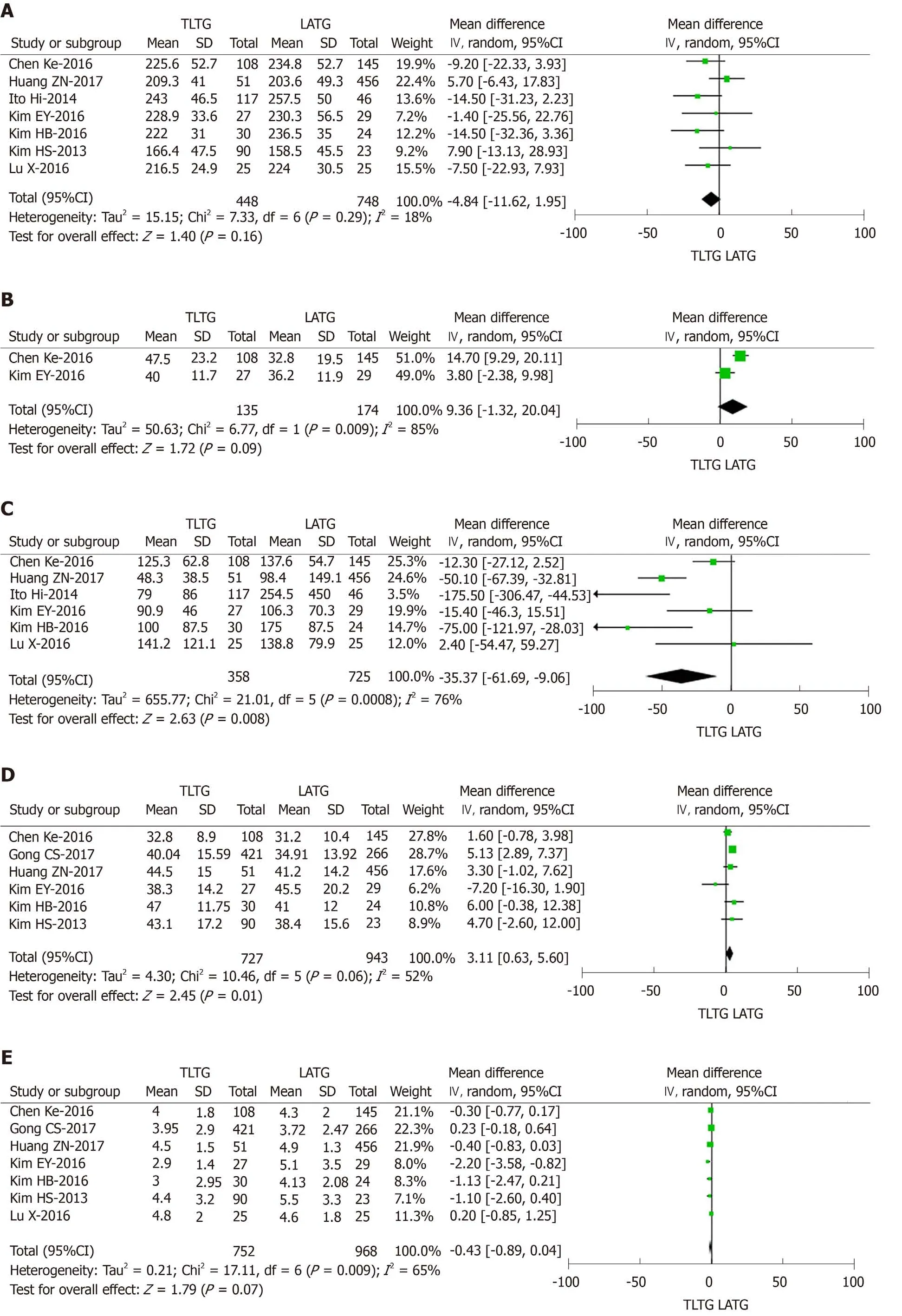
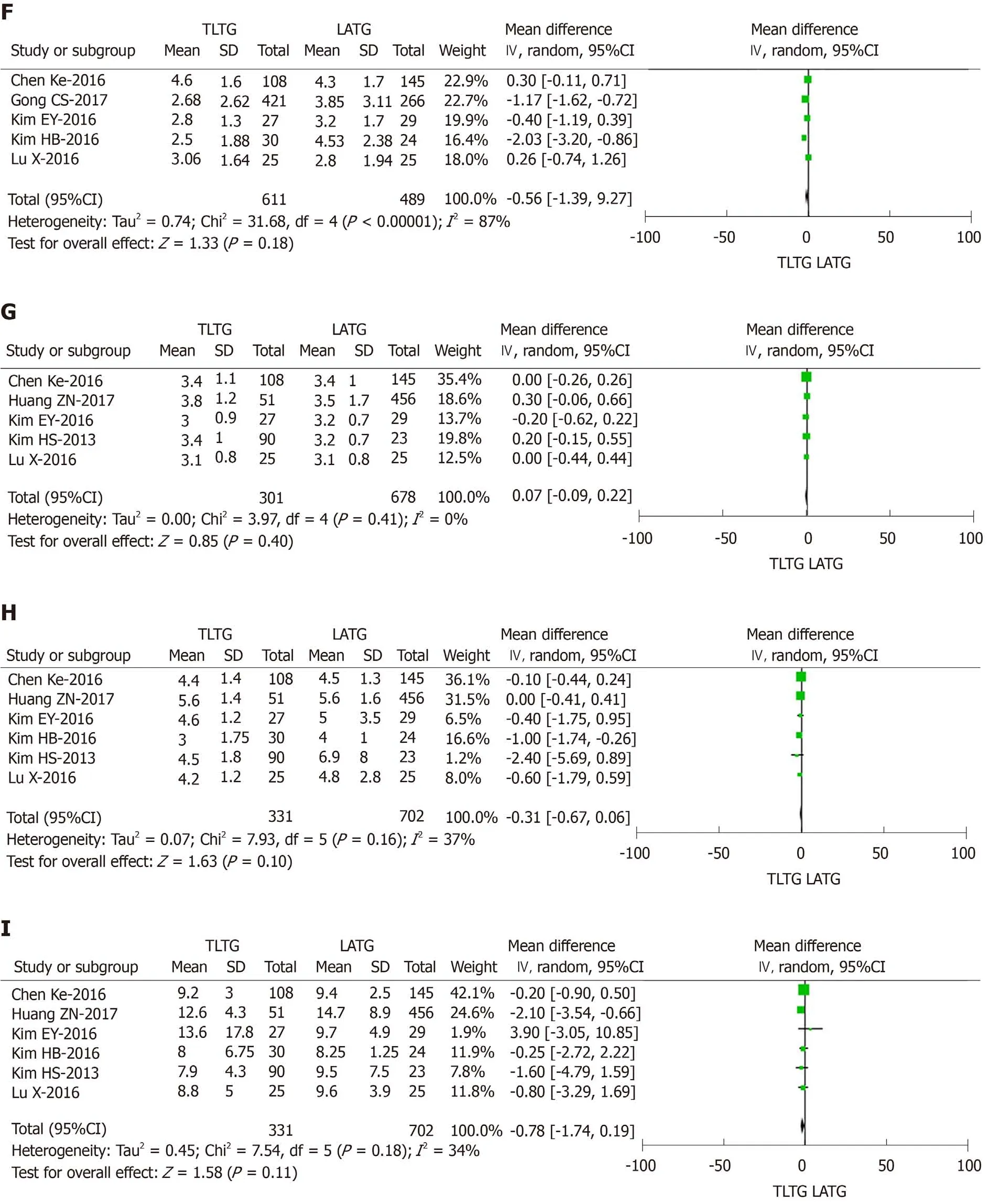
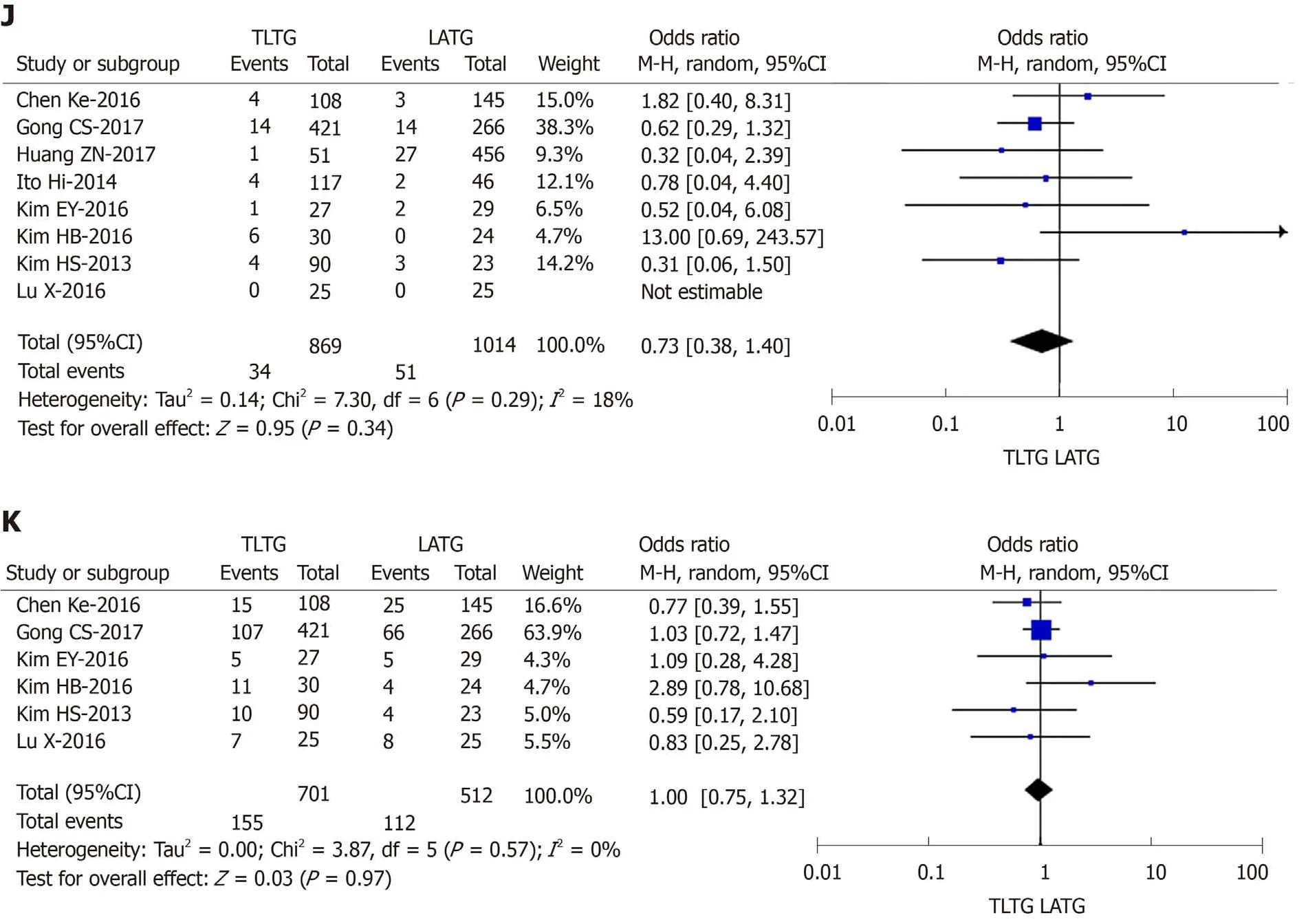
Figure 2 Forest plot based on intraoperative and postoperative clinical data.
In the eight studies included in this analysis,in seven[13-16,18-20]reconstruction was performed using Roux-en-Y anastomosis,while Huanget al[17]reported an isoperistaltic jejunum-later-cut overlap method.In six[13-15,17-19]of the eight studies,anastomoses were performed using a linear stapler,while Itoet al[20]used a circular stapler,and Chenet al[16]used multiple anastomoses.The present meta-analysis showed that the incidence of postoperative anastomosis-related complications was quite low in both the TLTG group (3.91%) and the LATG group (5.03%),and there was no significant difference between the two groups.Three studies[12,13,16]were removed in our sensitivity analysis,which resulted in no significant change to the final results.Therefore,these different anastomosis patterns did not affect the outcomes of our study,and our results are quite reliable.
It is generally believed that TLTG is time-consuming,as totally laparoscopic reconstruction of the digestive tract may prolong the operating time,and may even increase intraoperative blood loss.The results of this meta-analysis demonstrated that TLTG led to significantly reduced intraoperative blood loss compared to LATG,while there were no significant differences in the overall operating time and anastomosis time between the two groups.Less intraoperative blood loss in the TLTG group may be attributed to the following reasons:First,TLTG does not involve an abdominal auxiliary incision and results in smaller intra-abdominal wounds.Second,TLTG can reduce excessive tissue traction and decrease the risk of bleeding.In addition,laparoscopic operating skills may affect intraoperative blood loss,and the TLTG and LATG operators might be different.It was reported[25]that after learning the technique for totally laparoscopic distal gastrectomy (residual stomach and duodenal anastomosis),the operating time for TLTG will be significantly shortened.Thus,theoperating time may be related to the operator's proficiency in totally laparoscopic surgery.It is recommended that operators should master skillful laparoscopic techniques before performing TLTG,especially simple totally laparoscopic surgery,such as totally laparoscopic distal gastrectomy and other simulation operations.
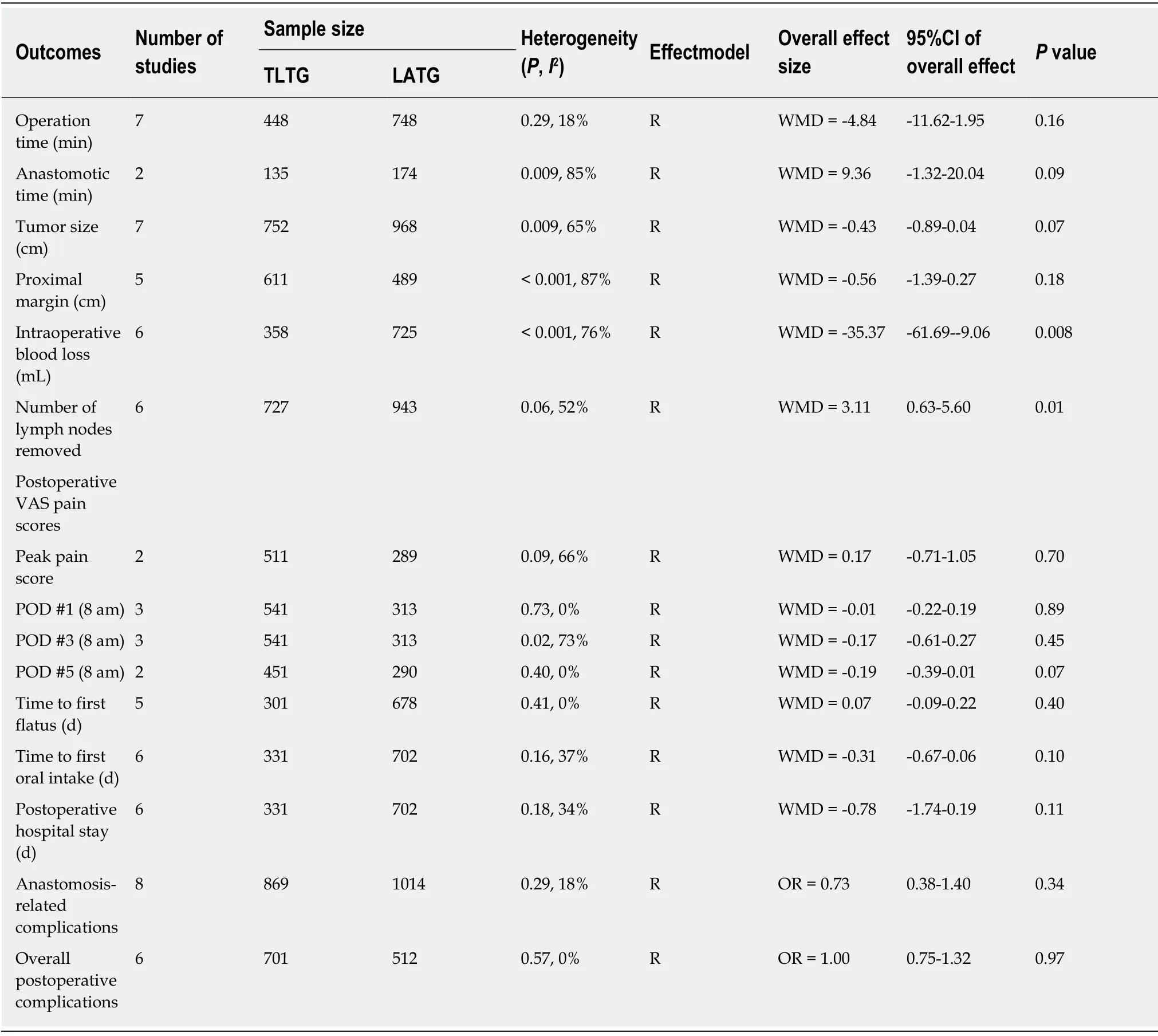
Table 2 lntraoperative and postoperative information in all included studies
It is very difficult to carry out total gastrectomy and esophagojejunostomy in obese patients by means of an abdominal auxiliary incision,and the surgical incision must be longer; therefore,the patient’s postoperative incision pain may be increased.Previous studies[5,13]have suggested that TLTG is still safe and favorable in overweight patients.Huanget al[17]found that TLTG is associated with less pain and thus improves quality of life after surgery.However,the present meta-analysis showed that no significant differences in BMI and pain scores were found between the TLTG group and LATG group.Thus,large-scale randomized controlled trials (RCTs) in patients with different BMIs are needed to prove whether TLTG is safe and favorable in obese patients and can reduce postoperative incision pain.
In general,radical surgery for malignant tumors involves obtaining adequate margins,thorough lymph node dissection,and standardized surgical procedures,and so forth[26].In totally laparoscopic gastrectomy,larger tumors may be difficult to remove from the abdomen due to the absence of an abdominal auxiliary incision.If the location of the tumor is near the esophagus,the length of the proximal margin resection is often insufficient,and it is difficult to achieve an ideal surgical outcome.Our meta-analysis showed that there was no significant difference in the length of the proximal margin and tumor size between the TLTG group and the LATG group,while a larger number of lymph nodes were retrieved in the TLTG group compared to the LATG group.Thus,it can be seen that TLTG is more conducive to radical surgery for gastric cancer,compared to LATG.
For patients with gastric cancer,no matter how successful the surgery is,postoperative recovery and efficacy are important factors.In the clinic,the short-term effects mainly rely on indicators such as the time to first flatus,time to first oral intake,postoperative hospital stay,and overall postoperative complication rate.The results of this meta-analysis showed that there was no significant difference in these clinical indicators between the TLTG group and the LATG group.
To date,we have found two similar meta-analyses (articles on TLTGvsLATG for gastric cancer).Of these,one article[16]was published in 2016 had only four related studies,and the sample size was small.Another article[27]was published in 2019 had 10 related studies,but it included studies reported in all languages (including English and other languages).In addition,we believe that the tumor size and postoperative pain scores are also worthy of attention in the comparative study of TLTGvsLATG for gastric cancer.However,neither of the two articles compared and explained these two points.In the present analysis,all the included studies were written in English and clinical information was sufficient,and we compared the short-term efficacy of TLTGvsLATG on gastric cancer in more detail and comprehensively.
This analysis had certain limitations.Firstly,all the included studies did not report and evaluate the long-term outcomes of totally laparoscopic radical gastrectomy,thus long-term efficacy differences between TLTG and LATG for gastric cancer need to be determined in future studies.In addition,all the included studies were retrospective,no blinded studies or RCTs were included,and the sample size may have been insufficient in this meta-analysis; thus,additional large-scale studies and RCTs are required.Furthermore,we focused on the safety and feasibility of intracorporeal esophagojejunostomy; however,laparoscopic operating skills may affect surgical outcomes,and the skills of TLTG and LATG operators may be different.
CONCLUSION
According to this meta-analysis,TLTG is technically safe and feasible,and has the advantages of being minimally invasive,reduced intraoperative blood loss and easier access to lymph nodes compared to LATG.However,large-scale RCTs are required to confirm these findings.TLTG should be encouraged in surgeons with sufficient laparoscopic experience.Totally laparoscopic gastrectomy is likely to be the surgical trend for gastric cancer in the future.
ARTICLE HIGHLIGHTS
Research background
Laparoscopic total gastrectomy for gastric cancer includes laparoscopic-assisted total gastrectomy (LATG) and totally laparoscopic total gastrectomy (TLTG).The main difference between LATG and TLTG is the route of digestive tract reconstruction.Needless to say,TLTG has the advantage of being more minimally invasive when compared with LATG.However,TLTG has not yet been promoted,mainly because the safety and feasibility of intracorporeal esophagojejunostomy of TLTG have not been determined.
Research motivation
If the safety and feasibility of intracorporeal esophagojejunostomy of TLTG for gastric cancer can be confirmed,TLTG may be more widely used in clinical practice due to its unique advantages.
Research objectives
The present meta-analysis was performed to compare the short-term efficacy of TLTG and LATG for gastric cancer,and investigate the safety and feasibility of totally laparoscopic esophagojejunostomy in order to obtain the best evidence to guide clinical practice.
Research methods
We collected high-quality published articles on TLTG vs LATG for gastric cancer via English language databases (such as PubMed,EMBASE,and Web of Science).All the basic conditions of patients (e.g.the first author,nationality,publication time,sample size,age,body mass index)and important clinical data related to surgery (e.g.the operating time,anastomotic time,intraoperative blood loss,tumor size,proximal resection margin length,number of retrieved lymph nodes,postoperative pain score,time to first flatus,time to first oral intake,postoperative hospital stay,postoperative anastomosis-related complication rate and overall complication rate)were extracted.A comprehensive and detailed comparison of two surgical approaches (TLTG vs LATG) for gastric cancer was performed by meta-analysis to explore the efficacy differences.
Research results
Compared with the LATG group,reduced intraoperative blood loss and a larger number of retrieved lymph nodes were found in the TLTG group.There were no significant differences in operating time,anastomotic time,tumor size,proximal resection margin length,postoperative pain score,time to first flatus,time to first oral intake,postoperative hospital stay,postoperative anastomosis-related complication rate and overall complication rate between the two groups.
Research conclusions
We confirmed the clinical safety and feasibility of TLTG for gastric cancer,and TLTG has the advantages of being minimally invasive,reduced intraoperative blood loss and easier access to lymph nodes compared to LATG.
Research perspectives
We speculate that totally laparoscopic radical gastrectomy for gastric cancer is likely to be the surgical trend for gastric cancer in the future.
 World Journal of Clinical Cases2020年6期
World Journal of Clinical Cases2020年6期
- World Journal of Clinical Cases的其它文章
- Repair mechanism of astrocytes and non-astrocytes in spinal cord injury
- Study on the correlation and predictive value of serum pregnancy-associated plasma protein A,triglyceride and serum 25-hydroxyvitamin D levels with gestational diabetes mellitus
- Significance of 125I radioactive seed implantation on growth differentiation factor and programmed death receptor-1 during treatment of oral cancer
- Computed tomography-based score model/nomogram for predicting technical and midterm outcomes in transjugular intrahepatic portosystemic shunt treatment for symptomatic portal cavernoma
- Allograft artery mycotic aneurysm after kidney transplantation:A case report and review of literature
- Oxcarbazepine for trigeminal neuralgia may induce lower extremity weakness:A case report
